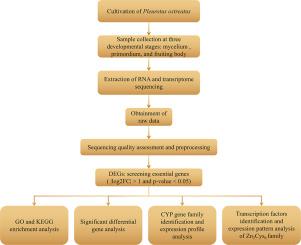Transcriptomic analysis of Pleurotus ostreatus during its fruiting body development
IF 4.2
2区 农林科学
Q1 HORTICULTURE
引用次数: 0
Abstract
Fruiting bodies of mushrooms are the macroscopic structures with high complexity and are formed under tight genetic regulations. Pleurotus ostreatus is one of the most widely cultivated and consumed edible mushrooms in the world. Systematic research about its genetic mechanisms of fruiting bodies development is still lacking. In this study, transcriptome sequencing was performed with samples from three developmental stages including mycelium (MS), primordium (PS), and fruiting body (FS). A larger number of DEGs were identified from MS to PS than PS to FS, suggesting the more complex transition from MS to PS. KEGG pathway and GO enrichment analyses revealed that the primordium development mainly involves cell proliferation, differentiation, protein synthesis while the fruiting body formation from primordium might be related to the maturation of cell functions or stable state. Some notably fruiting-specific genes, such as hemolysin, alpha amylase, FAD linked oxidase etc., were also uncovered. The study also identified 79 DEGs encoding cytochrome P450 monooxygenases (CYPs) belonging to 13 CYP Clans, which have different developmental expression patterns, suggesting their specific roles in different developmental stages. Sixty-seven transcription factors were also identified from all the DEGs and were categorized into 12 families, among which Zn2Cys6, comprising 19 DEGs, was the most prevalent family. The expression profiles of Zn2Cys6 family across three developmental stages revealed their roles in different developmental stages. These results provide valuable genetic information for understanding the complex fruiting process of P. ostreatus, and lay the foundation for further researches on gene function and genetic assisted breeding.

平菇子实体发育过程中的转录组学分析
蘑菇的子实体是高度复杂的宏观结构,是在严格的遗传调控下形成的。平菇是世界上种植和消费最广泛的食用菌之一。对其子实体发育的遗传机制尚缺乏系统的研究。本研究对菌丝体(MS)、原基(PS)和子实体(FS)三个发育阶段的样品进行转录组测序。从MS到PS鉴定出的deg数量多于PS到FS,表明MS到PS的转变更为复杂。KEGG途径和GO富集分析表明,原基发育主要涉及细胞增殖、分化和蛋白质合成,而原基形成子实体可能与细胞功能成熟或稳定状态有关。还发现了一些显著的果实特异性基因,如溶血素、α淀粉酶、FAD连锁氧化酶等。该研究还鉴定出了13个CYP宗族中编码细胞色素P450单加氧酶(CYP)的79个DEGs,这些DEGs具有不同的发育表达模式,提示它们在不同发育阶段的特定作用。从所有deg中鉴定出67个转录因子,并将其分为12个家族,其中Zn2Cys6是最常见的家族,包含19个deg。Zn2Cys6家族在三个发育阶段的表达谱揭示了它们在不同发育阶段的作用。这些研究结果为深入了解黄菖蒲复杂的结果过程提供了宝贵的遗传信息,为进一步研究黄菖蒲的基因功能和遗传辅助育种奠定了基础。
本文章由计算机程序翻译,如有差异,请以英文原文为准。
求助全文
约1分钟内获得全文
求助全文
来源期刊

Scientia Horticulturae
农林科学-园艺
CiteScore
8.60
自引率
4.70%
发文量
796
审稿时长
47 days
期刊介绍:
Scientia Horticulturae is an international journal publishing research related to horticultural crops. Articles in the journal deal with open or protected production of vegetables, fruits, edible fungi and ornamentals under temperate, subtropical and tropical conditions. Papers in related areas (biochemistry, micropropagation, soil science, plant breeding, plant physiology, phytopathology, etc.) are considered, if they contain information of direct significance to horticulture. Papers on the technical aspects of horticulture (engineering, crop processing, storage, transport etc.) are accepted for publication only if they relate directly to the living product. In the case of plantation crops, those yielding a product that may be used fresh (e.g. tropical vegetables, citrus, bananas, and other fruits) will be considered, while those papers describing the processing of the product (e.g. rubber, tobacco, and quinine) will not. The scope of the journal includes all horticultural crops but does not include speciality crops such as, medicinal crops or forestry crops, such as bamboo. Basic molecular studies without any direct application in horticulture will not be considered for this journal.
 求助内容:
求助内容: 应助结果提醒方式:
应助结果提醒方式:


